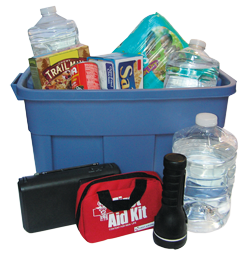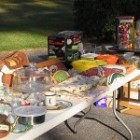No one really wants to think about food poisoning when they’re enjoying the outdoors and grilling food. But food safety is just as important to keep in mind whether you’re in the kitchen, at your backyard barbecue or grilling food at the company picnic.
The U.S. Food Safety and Inspection Service offers great guidance in “Grilling Food Safety 101″ online at http://www.foodsafety.gov/blog/grillingsafety.html. And, Ohio State University Extension offers more tips in a new video online at http://go.osu.edu/grillsafe.
It is especially important to make sure meat is cooked thoroughly when grilling out. People used to think that if meat looks pink, it isn’t done, and if it looks brown, it’s fine to eat. But food safety researchers have found that that’s false. Meat can be pink and be cooked thoroughly; it can be brown and not cooked enough. The only way to tell is by using a meat thermometer.
Be sure to insert the thermometer so it gets to the thickest part of the meat, but doesn’t touch any bone, which can distort the temperature reading. For burgers, insert the thermometer sideways and be sure it’s testing the center portion of the patty.
Safe temperatures include:
- Hot dogs: 165 degrees F or until steaming hot.
- Poultry, including ground poultry: 165 degrees F.

- Ground beef and other ground meat (not poultry): 160 degrees F.
- Whole cuts of pork, lamb, veal and beef, including steaks and chops: 145 degrees F (followed by a three-minute rest time).
- Fish: 145 degrees F.
Other things to bear in mind:
- Don’t take cooked food from the grill and put it on the same plate that held the raw food. After you place the food on the grill, either thoroughly wash the plate and the utensils you used to handle the raw food, or use a fresh plate and set of utensils for the cooked food. There’s just too great of a possibility that bacteria from the raw food — which is killed by thorough cooking — will recontaminate the food after it’s cooked.
- Don’t let food stay out for too long. The general rule is to not let perishable food sit out without refrigeration or heating for longer than two hours. But if it’s a hot summer day above 90 degrees, the risk that foodborne pathogens can multiply to dangerous levels increases, and the time limit drops to one hour.
Source: Ohio State University Extension, http://chowline.cfaes.ohio-state.edu/?p=335
Author: Linnette Goard, Field Specialist, Food Safety, Selection and Management, Family and Consumer Sciences, Ohio State University Extension, goard.1@osu.edu
Reviewer: Michelle Treber, Family and Consumer Sciences Educator, Ohio State University Extension, Pickaway County, Heart of Ohio EERA, treber.1@osu.edu









